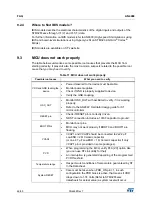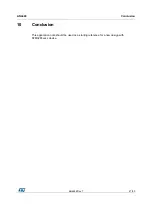
AN4488 Rev 7
33/50
AN4488
Clocks
49
6.2 LSE
OSC
clock
The low-speed external clock signal (LSE) can be generated from two possible clock
sources:
•
LSE user external clock (see
)
•
LSE external crystal/ceramic resonator (see
1.
“LSE crystal/ceramic resonators” figure:
To avoid exceeding the maximum value of C
L1
and C
L2
(15 pF) it is strongly recommended to use a
resonator with a load capacitance C
L
≤
7 pF. Never use a resonator with a load capacitance of 12.5 pF.
2.
“LSE external clock” and “LSE crystal/ceramic resonators” figures:
OSC32_IN and OSC32_OUT pins can be used also as GPIO, but it is recommended not to use them as
both RTC and GPIO pins in the same application.
3.
“LSE crystal/ceramic resonators” figure:
The value of R
EXT
depends on the crystal characteristics. A 0
Ω
resistor would work but would not be
optimal. To fine tube R
S
value, refer to AN2867 - Oscillator design guide for ST microcontrollers (
and electrical characteristics sections in the datasheet of your product for more details.
Figure 17. LSE external clock
Figure 18. LSE crystal/ceramic
resonators
/3#?/54
/3#?).
%XTERNALSOURCE
(I:
AI
(ARDWARECONFIGURATION
K^ϯϮͺKhd
K^ϯϮͺ/E
D^ǀϰϮϲϬϮsϭ
^dDϯϮ&dždždždž
>ϭ
>Ϯ
,ĂƌĚǁĂƌĞĐŽŶĨŝŐƵƌĂƚŝŽŶ
Z
yd;ϯͿ















































